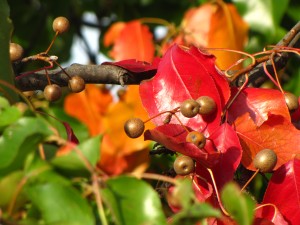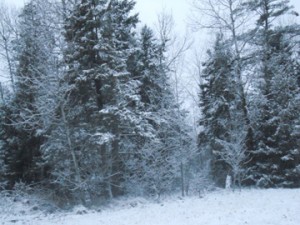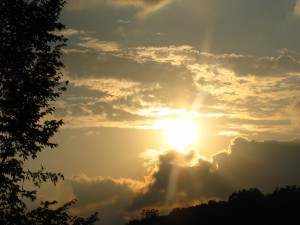As the sweetness of Summer passes and the shadow of winter creeps around, Katie has outdone herself. I guess it’s a matter of “I can’t just pick one…or two…or….”! Thanks Katie.
One great quote about summer is this F. Scott Fitzgerald’s Great Gatsby moment:
“And so with the sunshine and the great bursts of leaves growing on the trees, just as things grow in fast movies, I had that familiar conviction that life was beginning over again with the summer.”
Summer is a time of possibilities and preparation for the coming winter. It is one part of four interlocking seasons, and often reminds you of childhood–and of the four stages of life [baby, youth, adult, elder]. We often forget how limited and small life is, how important it is to make the best of life as quickly as possible–as soon it will be over. Famous American [and Pulitzer Prize winner] female poet Edna St. Vincent Millay [1892-1950] is a great poet for this time of year; she said: “I know I am but summer to your heart, and not the full four seasons of the year.”
Her poem “God’s World” is a really beautiful, interesting one:
O world, I cannot hold thee close enough!
Thy winds, thy wide grey skies!
Thy woods, this autumn day, that ache and sag
And all but cry with colour! That gaunt crag
To crush! To lift the lean of that black bluff!
World, World, I cannot get thee close enough!
Long have I known a glory in it all,
But never knew I this;
Here such a passion is
As stretcheth me apart,—Lord, I do fear
Thou’st made the world too beautiful this year;
My soul is all but out of me,—let fall
No burning leaf; prithee, let no bird call.
Another great summer/seasonal poem is American Ronald Johnson’s [1935-1998] long poem “Summer” [without the opening prose except from famous British naturalist Gilbert White [1720-1793]]:
1
Upon First Opening a Cuckoo
I saw the sweet-briar & bon-fire & strawberry wire now relaxed into intricate thicket.
It was as if seen in strong sunlight, flat & tapestried, all edge & definition.
Here, an airy bone shaped like a plowshare, there, vibratory membranes within a space
from which the song must come: a syrinx (hollow pipes of reeds) now silent
in return to the ‘Salliter’ of earth.
Little more than a drift of air, brought into form by plumes.
Mulch to stone.
Yeast of the clouds.
2
What the Earth Told Me
No surface is allowed to be bare,
& nothing to stand still. A man could forever study a pebble
& at last see dilations & expansions of the hills—
to pull the most slender stalk, is to jostle the stars,
& between the bearded grass
& man ‘looking in the vegatable glass
of Nature’, is a network of roots & suckers fine as hairs.
I threw a stone upon a pond & it bounded the surface, its circles interlacing
& radiating out to the most ephemeral edge.
Flint & Mica, Lichened Limestone, Shale & Sarcens, Sandstone, Soil.
I saw the wind moving on a meadow & the meadows moving under wind—
lifting, settling & accumulating.
Flint & Mica, Lichened Limestone,
Shale & Sarcens, Sandstone, Soil.
3
What the Air Told Me
It is breathed into Orpheus’ lyre & as rocks & trees & beasts
is divided there. Its origins strain
precedes the sound, by as much as echoes follow after:
the quivering of ‘cow-quake’, a ‘loud audible
humming of bees on the down’, stresses within the sustaining earth,
clouds of fleece & mare’s tail.
I saw with single eye, the facet of the fly—
the infinitesimal mechanics & all the metallic sheens
of a blue-bottle. In a land where the sun grows fat on cloud
& summer hasn’t come
till your foot can cover twenty daisies,
she came to the dark, open beak
& laid a myriad of eggs. And in two day’s time the dead
bird’s body simulated life: maggots in eye-socket &
under feather, in a subtle movement.
The White & The Glistening.
4
What the Leaf Told Me
Today I saw the word written on the poplar leaves.
It was ‘dazzle’. The dazzle of the poplars.
As a leaf startles out
from an undifferentiated mass of foliage,
A Mirage Of The Delicate Polyglot
inventing itself as cipher. But this, in shifts & gyrations,
grew in brightness, so bright the massy poplars soon outshone the sun . . .
‘My light—my dews—my breezes—my bloom’. Reflections
In A Wren’s Eye.
5
De Vegetabilibus
For there are splendors of flowers called DAY’S EYES in every field.
For one cannot walk but to walk upon sun.
For the sun has also a stem, on which it turns.
For the tree forms sun into leaves, & its branches & saps
are solid & liquid states of sun.
For the sun has many seasons, & all of them summer.
For the carrot & bee both bless with sun,
the carrot beneath the earth & the bee with its dusts & honies
For the sun has stippled the pear & polished the apple.
6
De Animalibus
For there are owls in the air & moles in the earth
& THEY ALSO have eyes.
For there are shapes of air which are OWL
& shapes of earth which are MOLE,
& the moles brings air to the earth & the owl, earth into air.
For the turtle’s back is another firmament & dappled like the cloud.
For there are birds who nest on the earth
& are feathered in its form.
For the rook & the worm are only one cycle out of many.
For man rejoices with rook & worm
& owl & mole & turtle,
& they are only one cycle out of many.
7
Turner, Constable & Stubbs
To see,Turner had himself lashed to the ship’s mast
& Constable sat still in the fields
till something came—a bird—‘some living thing appropriate to
the place’. He noted the wind’s direction, pile
of clouds, the time of day. Stubbs
fixed an iron bar to the ceiling of his room, with hooks
of various sizes & lengths, in order to suspend the body of a horse.
The horse remained for six or seven weeks
‘until no longer endurable’.
The form of muscles, blood vessels & nerves was retained
by tallow injections—Stubbs methodically
cutting to the skeleton, making full length drawings
& studies of the ear & nose.
‘He was possessed of great physical
strength, being able,
it is said, to carry a dead horse on his back
to a dissecting room,
at the top of a narrow flight of stairs’.
The work was finished in eighteen months.
8
Natural Productions, Occurrences & Antiquities
‘August is by much the most mute month’, yet,
the air may be so strongly electric
that bells may ring & sparks be discharged in their clappers:
‘put a bird in motion, et vera incessu patuit . . .’
To distinguish a bird by its ‘air’, to ‘hear’
the buoyant owls—woodpeckers rising & falling in curves
Gilbert White quotes from the Latin: He preferred
the sounds of birds to those of men. The music of men left his mind
disturbed by engaging his attention
with its rise & fall, while the warbling
of birds left no such hold
‘to tease my imagination & recur irresistibly
at seasons . . . ’
All day the cobweb fell silently
in the air, till whole
baskets-full lay round about, & still
more descending.
9
The Leaves of Southwell
Maple & hawthorn & oak. Crow-foot & cinquefoil
(Aubrey’s Midsummer Silver?).
Vine & ivy & hops. Rose, bryony (a Mandrake), geranium, mulberry,
wormwood. Fig, bittersweet & blackthorn.
It is an assemblage (a community?) including its dragons with
crisply carved acorns.
Two hounds devour a hare. A bird seizes a grape with its
beak. Both green men & the winged
fruit of maple are in hierarchy of accuracy—the ribbed & the delicate
ascending to the general. But here, a throat
come aleaf, there a branch held aloft.
And a kind of greening speech comes from those mouths
all but winged—each leaf
cleft & articulate. Southwell, of the leaves
of limestone: trefoil, quatrefoil, cinquefoil (as foil means
leaf): a ‘burnisht corall’ & geranium
brain: cranesbill, crow-foot: blackthorn & whitehorn,
quickthorn, Jack-in-the-green:
a man cleft, as Mandrakes, the ‘man-shaped
dragon’, Mandragora.
10
Exhibit from Frederik Ruysch’s Anatomical Museum
A skeleton balances an injected spermatic plexus
in one hand & a coil of viscera
in the other. Minatory assortments
of calculi of all sizes
occupy the foreground. In the rear, a
variety of injected vessels, backed by an inflated & injected
tunica vaginalis,
combined to form a grotesque & arboreal
perspective. Another skeleton,
in extremis, is grasping a skeleton
of that emblem of insect mortality, the mayfly, & a third
is performing
a composition ‘expressing the sorrows of mankind’
on a violin, symbolized
by bundles of arteries & a fragment
of necrotic femur.
Bones are arranged to represent
a cemetery—wrists are adorned with organic & injected
frills—& human, comparative
& pathological exhibts
are mingled, as the exigencies of space required.
11
‘Unless the Humming of a Gnat is as the Music of the Spheres
& the music of the spheres is as the humming
of a gnat . . . ’ A spectre came, transparent-winged,
out of the interstices of light,
& shadow went up like smoke & everywhere
the hills were as clouds over valleys of water, rippling
& reverberating.
And before him the sands of the beach swarmed as insects, close-knit
in electrical flight . . .
‘For MATTER is the dust of the Earth,
every atom of which is the life.
For the flames of fire may be blown thro musical pipes’.
And everywhere the hills were as clouds over
valleys of water, rippling
& reverberating.
12
What the Light Told Me
It is now a circle, now a spiral or wheel.
It merges with the eye, with a wing or a sickle-shaped horn.
It takes on the form of beasts—a dragon, fish, or bird.
As an orb, at summer soltice,
it balances on the altar-stone at Stonehenge—
& as beam, expands, elongates, twists & ‘attenuates
itself into leafen gold
as a covering for the quince’.
With arc & parabolic
& serpent-oblique—‘muscial in ocular
harmony’. Expanding, elongating, twisting
& attenuating.
An encompassing eye.
Within and out, round as a ball—
With hither and thither, as straight as a line.
Slight as a fox-whisker,
spiraled, twined—rayed as chicory-flower.
Within and out, round as a ball—
With hither and thither, as straight as a line.
With lily, germander
And sops-in-wine. With sweet-briar and
Bon-fire and strawberry wire
And columbine.




Janet, thanks for your knowledge. The heck with that poetry group. Think about joining CWG and writing poetry again. I know we could find a place for you on Poetry Sunday. Blessings!
Our poetry genius is Katie O’Neil. We are lucky to have her. All I am is the commentator!
Thank you for these. They provided such a peaceful Sunday morning reflection as I stopped at the computer on the way to mass. Could I point out in the Edna St. Vincent Millay poem the use of rhyme? One often runs into pundits who repeat the cliche that rhyme is dead, and one wearies of arguing with it. But look how effectively, how subtly, it is used here, see how it reaches into the heart like a tiny key, to unlock the reverence and release it. Rhyme is magical.
This post makes me wish to write poetry again. I haven’t since the nineties when my poetry group in Pittsburgh began circulating jokes about abortion, and I protested, saying I didn’t mind if we disagreed but I didn’t want the matter to be trivialized. But they said no, abortion IS a joke and those who resist it are jokes. It’s no big deal. So I no longer felt they could comment on my own poetry with authority and I left the group. I miss it very much. I look back at the poems I have written over the years with wonder, how they capture that precious moment, like nothing else.
Thanks again! Keep us reading poetry!!!